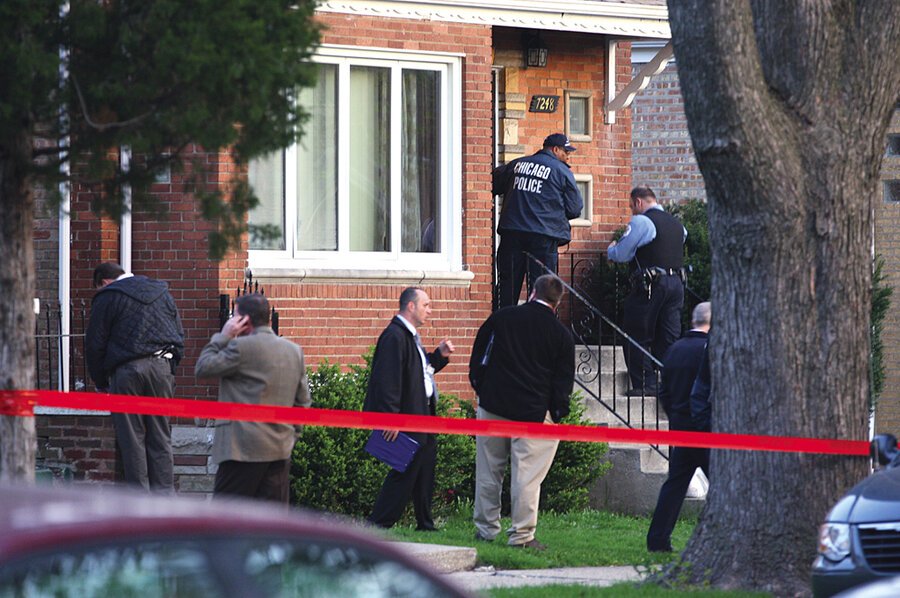In Chicago, can community involvement combat gang violence?
Loading...
| Chicago
The challenges posed by gun violence in Chicago came into sharp focus last month with two incidents.
On April 12, a 17-year-old was gunned down. As he lay dying, he refused to tell police the name of his murderer.
Then on April 21, a bullet killed a 20-month-old girl as she sat in a car. The alleged gunman, who turned himself in, reportedly intended to shoot her father.
Heightened gang violence and an unusually warm spring are both being blamed for a rise in homicides in the city, particularly on the South Side. By late last month, the homicide count for the year had reached 116 – 15 percent more than for the same period in 2009.
As Chicagoans mourn the multiple tragedies, they're asking: What needs to be done to stem the violence?
Two state lawmakers suggested to Illinois Gov. Pat Quinn (D) that the National Guard might be needed to curb the violence. Governor Quinn, as well as Chicago Mayor Richard M. Daley, dismissed that idea.
Are more police needed on the streets? A number of people, starting with officers themselves, have called for this. Others, however, view such a call as rhetoric.
For many people, a deeper solution lies in more community involvement. At the least, they say, the code of silence that the dying 17-year-old observed needs to be broken. Another key could be more people joining hands to help prevent violence.
"We're not going to arrest our way out of these problems," says Dennis Rosenbaum, director of the Center for Research in Law and Justice at the University of Illinois at Chicago. But force may be necessary, he notes: Chicago's dense concentration of "poverty and gangs and guns and drug markets" requires "a sizable and specialized response" such as increased SWAT teams and gang units.
Although violence has flared in the city this spring, it's worth noting that over a 10-year period, homicides in Chicago are actually down. Between 1999 and 2009, homicides fell 29 percent. In addition, emphasizes Chicago Police Superintendent Jody Weis, this season's problem is not widespread. It's concentrated in less than 9 percent of all city blocks.
But the problems that cost the 20-month-old her life this spring are deep. Some critics of the police are zeroing in on the number of officers, saying that Chicago is woefully behind comparable major cities in fortifying police ranks.
Union president Mark Donahue is pressing for more officers on the streets. "Without having the proper resources and proper personnel, your response time is going to be slower, and your proactive police presence in the neighborhoods is going to be less," he says.
The Midwest's police-per-population rate is below average compared with other parts of the country, according to 2008 data from the US Bureau of Justice Statistics. While the average rate in US cities was three full-time officers per every 1,000 inhabitants, the Midwest averaged 2.7 while the Northeast averaged 3.4. That same year, Chicago tallied 13,359 police officers, about 37 percent of New York City's officer count, which was 35,761.
But Mr. Rosenbaum cautions against drawing too many conclusions from New York's totals. "It's hard to make comparisons to New York because it may have its own set of problems, like terrorism," he says.
As for Chicago, if it tries to bolster the force by recruiting many new officers, that task won't be easy: The city council recently passed a contract that includes a 2 percent yearly raise for officers – far below what the union had hoped.
Another option for police is to retool what officers do each day so they spend less time on nonviolent issues like traffic violations.
"You have to ask yourself, why are we paying law enforcement $60,000, $70,000 a year to write a few tickets? It doesn't pan out," says Rande Matteson, a former agent for the US Drug Enforcement Administration who now teaches criminal justice at Saint Leo University in Florida.
Rosenbaum at the University of Illinois is similarly skeptical that more police will suffice as the solution. In his view, energies should be directed toward cracking the "no snitching" culture in certain city neighborhoods.
"If you want to ask the police to do their job, you have to help them," he says.
One way police themselves have dealt with this situation was to launch "Silence Kills" – a campaign that encourages people to send anonymous tips through text messaging.
But Rosenbaum is also thinking more broadly than the "no snitching" problem. Curbing city violence, he says, is a responsibility that must be shared by the public.
"Public safety is a product that has to be jointly produced by the police and all authorities in the community," such as church leaders, community organizers, and schools. "When we don't work together, that's when we're going to have problems."
One example of working together is CeaseFire Chicago, which is part of a wider organization that seeks out conflicts in neighborhoods and provides emergency mediation so they don't lead to violence.
Tio Hardiman, CeaseFire's local director, considers street violence "a public health issue" that involves other issues such as unemployment and domestic violence. He says his organization has prevented 119 homicides since January and 1,400 since 2004.
No matter how many officers a city has, Mr. Hardiman says, "You still can't get there in time to stop the act."
Rather, he says, "You have to change the behavior and mind-set that are involved in the violence."





